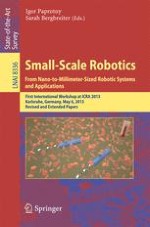This book contains selected contributions from some of the most renowned researchers in the field of small-scale robotics, based in large part on invited presentations from the workshop “The Different Sizes of Small-Scale Robotics: from Nano-, to Millimeter-Sized Robotic Systems and Applications,” which was held in conjunction with the conjunction with the International Conference on Robotics and Automation (ICRA 2013), in May 2013 in Karlsruhe, Germany. With many potential applications in areas such as medicine, manufacturing or search and rescue, small-scale robotics represent a new emerging frontier in robotics research. The aim of this book is to provide an insight to ongoing research and future directions in this novel, continuously evolving field, which lies at the intersection of engineering, computer science, material science and biology.
